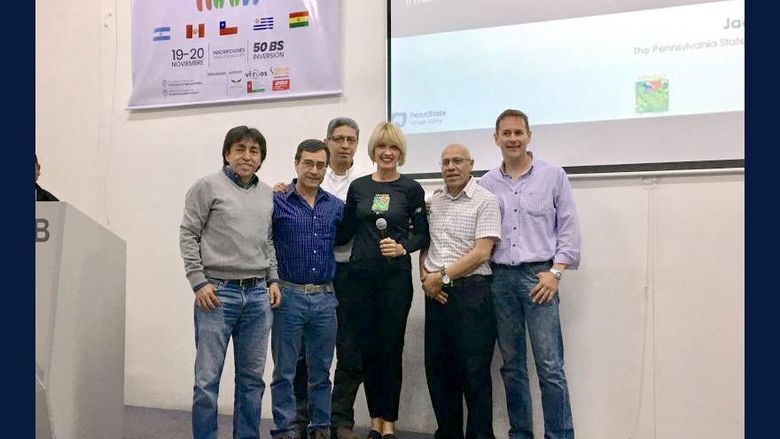CENTER VALLEY, Pa. — Data collection provides the information researchers need to make informed decisions about a wide range of issues. Penn State Lehigh Valley (PSU-LV) students participated in a joint statistical analysis project on health-related data with students from Osh University in Uzbekistan as part of the Penn State Experiential Digital Global Engagement (EDGE) Project. Students collected data sets related to cases of tuberculosis in Uzbekistan, and performed statistical analysis to determine contributing factors, associated correlations, and what efforts could mitigate the spread of the disease going forward.
EDGE is a Penn State project-based teaching and learning approach that encourages the development of intercultural competencies across shared learning environments using the Internet and other technology-driven tools. Instructors and students foster meaningful relationships with peers in geographically distant locations from diverse cultural backgrounds.
Larry Musolino, assistant teaching professor, mathematics, designed a joint statistical investigation for students in his STAT200 class with a faculty member from Osh University to investigate tuberculosis data.
“For this project, we wanted students to use statistical data analysis to improve health outcomes. Our data analysis and predictions could provide meaningful insights to better understand the reasons for the spread of the disease and help to guide mitigation strategies. We looked over the available data sets made available by the National Statistical Committee of the Kyrgyz Republic and selected tuberculosis datasets for the analysis,” Musolino said. “Tuberculosis is problematic in Uzbekistan — much more so than in the U.S. — the incidence rate for tuberculosis is about 20 times higher in Uzbekistan as compared to the U.S.”
Small teams comprised of students from PSU-LV and Osh University were assembled. The teams did not have exactly the same project goals — Osh University students used the same data sets but had different learning objectives.
“We focused a little more on regression analysis and predicting tuberculosis rates, and were they a cause for concern? My counterpart wanted to focus more on geographic correlations to determine if specific locations had significantly higher incidence of tuberculosis. I had about 30 students in my class; there were about 12 in the Uzbekistan group, as well as graduate students," Musolino said.
Meetings were held via Zoom, and Musolino said there were definite challenges: “Two of the biggest problems we had to deal with were the time difference — Uzbekistan is about nine hours ahead of us — and the language differences. We had a kickoff meeting where we presented the project to all students, and we met at 8 a.m. Penn State time, which was 6 p.m. Uzbekistan time.”
Musolino said the meetings required using an interpreter. Then, following the kickoff meeting, smaller student groups met via Zoom on a periodic basis to exchange information and provide updates on the statistical data analysis.
Hanna Shames, a junior majoring in agricultural science with a focus on horticultural studies, said she enjoyed the project.
“I pick up statistics very easily, so I didn’t find the project that difficult. It was interesting to speak with students from other countries we wouldn’t normally speak to or work with. [This project] opened our eyes to see what others are dealing with that we’re not dealing with here," she said.
Shames added this was a project that will likely serve her well in the future, as she expects to collect various types of data related to agriculture for a wide range of purposes.
Another student, Elijah Randolph, a sophomore majoring in rehabilitation and human services, said the project was a valuable application in data collection. “This gave me more practice in statistical analysis and how it applies to a real-world setting. We learned about the difficulties in different countries. When I’m in the workplace, this helped me understand what I can expect to occur [in gathering data].”
Despite the obstacles, Musolino said the students did well.
“Even though it was a group project, each student submitted their own project," said Musolino. "A couple of things popped up — tuberculosis rates had been decreasing in Uzbekistan for many years, but as of 2021, it’s trending back up. There are some correlations to COVID. Tuberculosis is a respiratory disease. People were masking and social distancing due to COVID, which also helped to reduce the incidence of tuberculosis, but now that many people are no longer following these precautions, we predict this will result in an increase in the incidence of tuberculosis in Uzbekistan.
"The other interesting result was a statistically significant disproportionate number of cases among males versus females, particularly in the 18-34 age range," continued Musolino. "The class hypothesized this is likely due to the increased social activity for this age group with the corresponding likelihood to spread the disease due to this social activity. Overall, this was an excellent project for STAT200 students to gain hands-on experience with real-world datasets and statistical data analysis. In addition, students had the opportunity to interact with students from another country to understand global challenges affecting other countries.”





